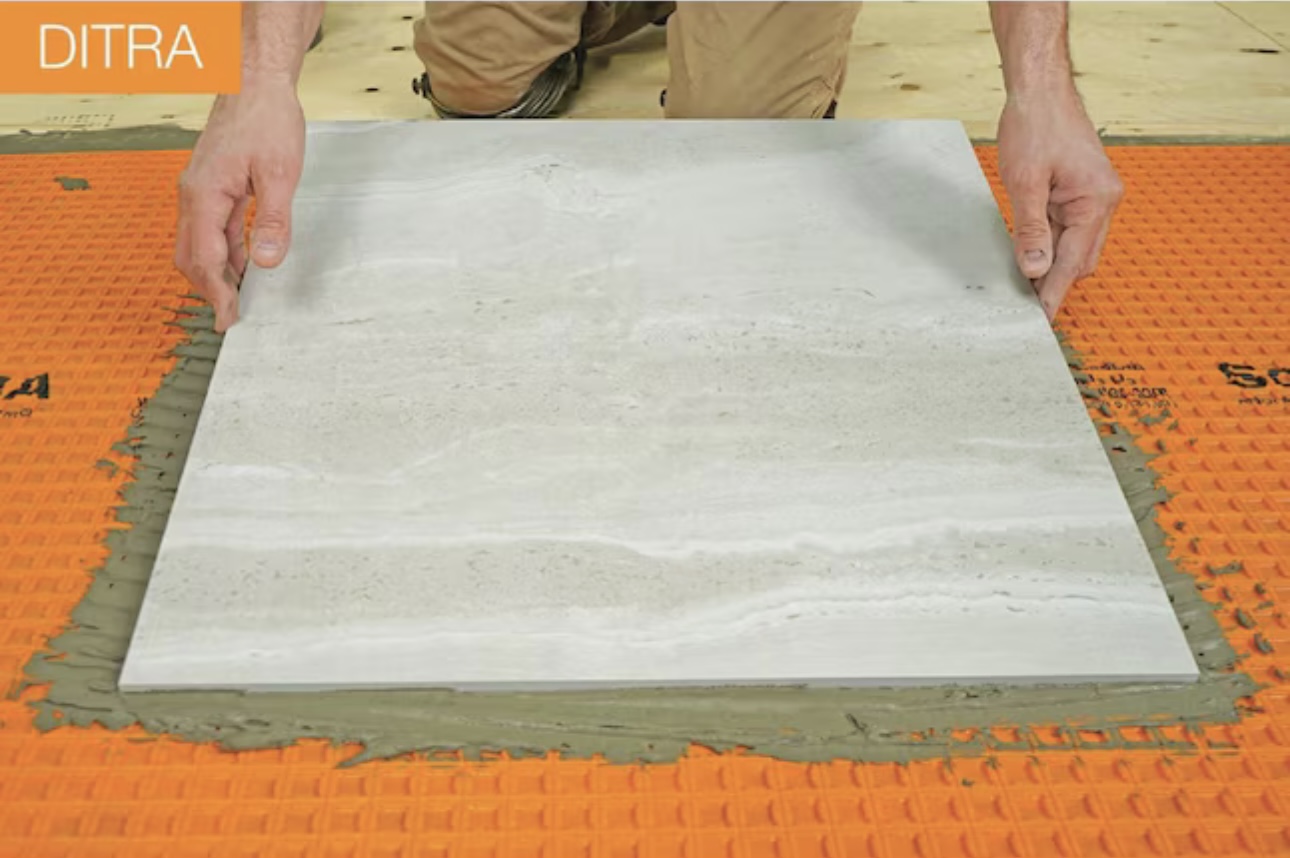What is antifracture membrane and why is it so important?

Concrete as a Substrate
Concrete can generally be categorized into two types: the type that is cracked and the type that will crack. Regardless of how well it is mixed or poured, concrete is susceptible to various stresses, including temperature changes, settling, and seismic activity, which can lead to cracks over time. As a result, installing tile directly over concrete without the protection of an anti-fracture membrane poses a significant risk. The absence of this protective layer means that any cracks that develop in the concrete substrate can easily transfer to the tile surface, resulting in unsightly damage and compromising the integrity of the installation. Therefore, to safeguard against these inevitable stresses, utilizing an anti-fracture membrane becomes essential for ensuring a durable and long-lasting tile floor or patio.
An anti-fracture membrane is a flexible layer applied beneath tile flooring or exterior patios designed to prevent cracks in the substrate from transferring to the tile surface. These membranes are crucial in areas subjected to movement, such as in regions with expansive soils, heavy foot traffic, or seismic activity.
Recommendations and Benefits
In Southern California, where seismic activity is a constant concern, an anti-fracture membrane is highly recommended for several reasons:
- Crack Prevention: The primary function of an anti-fracture membrane is to absorb stresses and isolate the tile from cracks that may develop in the substrate due to ground movement or settling.
- Enhanced Durability: By preventing cracks from reaching the tile, the membrane extends the life of the flooring and reduces the need for costly repairs or replacements.
- Moisture Barrier: Many anti-fracture membranes also serve as moisture barriers, protecting the substrate and tile from water damage, which is especially important for exterior patios.
- Ease of Installation: These membranes are generally easy to install and can be applied over various substrate types, making them versatile for different projects.
- Improved Comfort: The flexibility of the membrane can also provide a more comfortable feel underfoot, enhancing the overall user experience.
Key Manufacturers
- Schluter Systems: Known for their DITRA and DITRA XL membranes, which provide effective crack isolation and waterproofing.
- Custom Building Products: Their RedGard and Mapeguard membranes are well-regarded for both anti-fracture and waterproofing capabilities.
- LATICRETE: Offers LATICRETE 9235 and LATICRETE 125 as anti-fracture membranes that also provide waterproofing.
- Manual: LATICRETE Technical Data Sheets

Installation:
While specific installation instructions vary by manufacturer, the general steps include:
- Surface Preparation: Ensure the substrate is clean, dry, and structurally sound.
- Application: Roll out the membrane over the prepared surface, ensuring complete coverage.
- Adhesive: Use the recommended adhesive to bond the membrane to the substrate.
- Tile Installation: Once the membrane is set, tiles can be installed directly on top.
Always refer to the manufacturer’s guidelines for specific installation practices to ensure optimal performance.
Risks of Not Using an Anti-Fracture Membrane

- Cracked Tiles: Without a membrane, cracks in the substrate can propagate through to the tile, leading to unsightly damage and potential safety hazards.
- Increased Repair Costs: Repairing or replacing cracked tile can be significantly more expensive than the initial cost of installing a membrane.
- Structural Issues: In a seismic zone like Southern California, neglected substrate movement can lead to more serious structural issues over time.
- Water Damage: Without a moisture barrier, water infiltration can compromise the integrity of the substrate and tile, leading to mold and mildew growth.
In Southern California’s seismic zone, the use of an anti-fracture membrane under tile flooring and exterior patios is not just a recommendation; it is essential for protecting your investment and ensuring the longevity of your flooring. By selecting a quality product from reputable manufacturers and following installation guidelines, owners can enjoy beautiful and durable surfaces that withstand the challenges of their environment.
At Costo Construction, we offer consulting based on decades of in-field experience to best plan your tile installation. We take into account the size and type of tile, the environment it will be installed in, the substrate preparation, the eventual finished heights relative to cabinetry, passageways, steps, thresholds etc. We also offer a consultative approach to the cost and scheduling considerations and of course, we also discuss all applicable warranties. We work closely with Architects, Designers, suppliers, manufactures and trade qualified floor leveling contractors and tile & stone installers to ensure our colleagues and clients are making well informed decisions and prioritizing these types of risk mitigation efforts and products into their projects.
To ensure the highest quality and compliance in tile and stone projects, we actively engage in thorough research and stay informed about the latest standards published by recognized testing and standards bodies, including the American National Standards Institute (ANSI) and the American Society for Testing and Materials (ASTM). These organizations develop and publish standards that ensure quality and safety in construction, particularly for tile and stone installations. ANSI establishes overarching guidelines, while ASTM provides specific testing methods and performance criteria. Additionally, the Tile Council of North America (TCNA) contributes by offering industry standards tailored to ceramic tile and stone installation. By regularly reviewing updates and revisions, subscribing to industry publications, participating in relevant seminars, and collaborating with trade organizations, we remain current on best practices and code compliance. This commitment not only enhances our expertise but also ensures that our projects meet or exceed industry benchmarks, ultimately delivering reliable and durable results for our clients.
If you are considering a mortared interior or exterior tile or concrete paver installation, of any type of size, feel free to contact us to learn more.
We look forward to delivering the level of service and information your project and property deserve.

Antifracture Membrane: The Essential Solution for Durable Tile and Stone Installations in California
In California’s challenging construction environment—marked by seismic activity, temperature fluctuations, and expansive soils—antifracture membrane has become an indispensable component of successful tile and stone installations. Especially in slab-grade foundations and commercial or residential buildings, using an antifracture membrane over substrates and beneath hard-fixed tile flooring and decking is crucial to prevent cracking, ensure longevity, and maintain aesthetic appeal.
This comprehensive article explores what antifracture membrane is, why it is essential in California’s construction landscape, and how Costo Construction leverages top-quality products and innovative systems like raised pedestal systems to deliver durable, high-performance tile installations. We will also discuss warranty considerations and the importance of proper planning and execution to avoid cracking and grout failure.
What Is an Antifracture Membrane?
Antifracture membrane is a flexible, waterproof, and crack-isolating layer installed over substrates before laying tile or stone. Its primary purpose is to absorb and distribute movement caused by substrate cracking, seismic shifts, temperature changes, or soil settlement, thereby preventing cracks from transferring to the finished surface.
According to the Tile Council of North America (TCNA), antifracture membranes are typically made of elastomeric polymers or modified bitumen, applied as sheets or liquid coatings. They act as a stress-absorbing layer, providing a continuous, flexible barrier that protects the tile and grout from cracking due to underlying substrate movement.
Why Is Antifracture Membrane Necessary in California?
California’s unique geological and environmental conditions make the use of antifracture membranes especially critical:
Seismic Activity: Earthquake-induced ground movement can cause pre-existing cracks or induce new ones in concrete slabs. Without an antifracture membrane, these cracks can transfer directly through tile and grout, leading to costly repairs and aesthetic degradation.
Slab-Grade Foundations: Many residential and commercial buildings utilize slab-on-grade foundations that are prone to cracking due to soil movement and temperature fluctuations. Installing an antifracture membrane over these slabs provides an essential crack-isolation barrier.
Temperature and Soil Expansion: California’s climate variations and expansive clay soils can cause movement in substrates. An antifracture membrane accommodates these movements, protecting tile installations from cracking.
High Moisture and Waterproofing Needs: Many exterior applications and wet areas require waterproofing, which antifracture membranes can provide in addition to crack isolation.
According to an article by Construction Dive, the importance of crack-isolation membranes in seismic zones cannot be overstated. They emphasize that proper installation of antifracture membranes significantly reduces warranty claims related to cracked tile and grout, saving homeowners and contractors money over the long term.
Products Costo Construction Utilizes for Antifracture Membranes and Tile Installations
At Costo Construction, we prioritize quality and durability in every tile and stone installation. Our selection of antifracture membranes includes industry-leading products tailored for both vertical and horizontal applications:
Liquid Applied Membranes:* We often use elastomeric liquid membranes such as *Mapei Mapeguard WP* or *Sikalastic** products. These are applied as a seamless, flexible layer that conforms to substrate movement and provides excellent crack isolation.
Sheet Membranes:* For larger areas or exterior balcony and deck applications, we employ sheet membranes like *Schluter-DITRA* or *Laticrete SpectraLock** membranes, which are easy to install and provide reliable crack bridging.
Hybrid Systems:** In some cases, we combine liquid and sheet membranes to maximize crack resistance and waterproofing, especially in seismic zones.
Our team works closely with structural engineers and product manufacturers to ensure the right membrane choice for each project’s specific substrate, environmental conditions, and load requirements.
Incorporating Raised Pedestal Systems as an Alternative
In exterior applications, particularly for decks and walkways, raised pedestal systems have emerged as an innovative alternative to traditional hard-fixed tile surfaces. These systems consist of adjustable pedestals that support tiles or stones, creating a ventilated, level surface above the substrate.
Advantages of raised pedestal systems include:
Elimination of Direct Contact:** Since tiles are not adhered directly to the substrate, cracks in the slab do not transfer to the surface.
Drainage and Ventilation:** The open space beneath allows water to drain freely, reducing moisture buildup and preventing freeze-thaw damage.
Easier Maintenance and Repairs:** Individual tiles or stones can be removed or replaced without disrupting the entire surface.
Costo Construction utilizes raised pedestal systems when we want to avoid the risks associated with slab movement and cracking, particularly in exterior decks, terraces, and rooftop patios. These systems are especially effective in seismic regions, where ground movement can otherwise compromise traditional tile installations.
Warranty and Quality Assurance: Preventing Cracks and Grout Failures
One of the most common warranty issues in tile and stone installations involves cracked tile and grout joints. These problems often stem from substrate movement, improper substrate preparation, or failure to use proper crack-isolation methods like antifracture membrane.
Key considerations include:
Proper Surface Preparation:** Ensuring substrates are clean, level, and free of debris before membrane installation.
Correct Application:** Applying membranes as per manufacturer instructions, with adequate coverage and curing.
Design Planning:** Incorporating expansion joints and movement joints into the design to accommodate substrate movement.
Use of Quality Materials:** Selecting proven membranes and adhesives compatible with the substrate and environmental conditions.
When executed correctly, the combination of a high-quality antifracture membrane, proper substrate prep, and suitable joint placement dramatically reduces the risk of cracks, ensuring long-lasting, warrantable installations.
Conclusion
Antifracture membrane is an essential element in modern tile and stone installations, particularly in California’s seismic and expansive soil environment. Its ability to prevent cracks and grout failures extends the life of flooring and decking, reduces costly repairs, and enhances aesthetic longevity.
At Costo Construction, we understand the importance of antifracture membrane systems. Our team is trained and certified in the latest installation techniques and works closely with top product manufacturers to select the best solutions for each project. Whether installing tile on horizontal surfaces, vertical walls, or innovative raised pedestal systems, we prioritize durability, safety, and quality.
Investing in antifracture membrane technology and proper execution ensures your investment withstands California’s environmental challenges and seismic activity, providing peace of mind and protecting your property for years to come. https://costoconstruction.com/uncategorized/best-value-construction-manager/
External articles supporting the importance of antifracture membranes:
https://www.tcnatile.com/
https://www.constructiondive.com/
https://laticrete.com/

